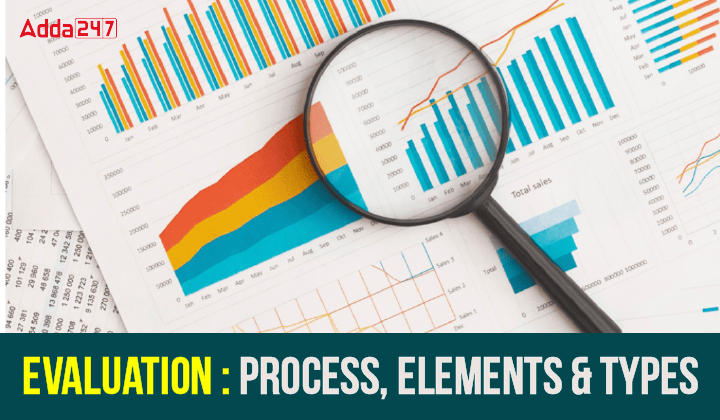Table of Contents
The evaluation process refers to a systematic and structured approach used to assess and measure the effectiveness, quality, or performance of a particular project, program, process, or individual. The purpose of evaluation is to gather evidence, analyze data, and make informed judgments or decisions based on the findings. Evaluation is a process of judging what students have learned from the entire teaching-learning process.
- UGC defined Evaluation as “Evaluation is the process of determining based on evidence and interpretations gathered through examination and assessment and on the basis of agreed-upon criteria.”
- According to Tuckman,” Evaluation is a process wherein the parts, process or outcomes of the programme are examined to see whether they are satisfactory, particularly with reference to the programs stated objectives of our own standards of excellence.”
Check: UGC NET 2024 Download Link
Characteristics of Evaluation
Following is a brief list of different characteristics of the evaluation system:
- Evaluation is a continuous process.
- It is comprehensive and includes everything.
- It is learner-centred
- It follows the remedial approach
- It helps to frame effective teaching methods
- It’s a cooperative process where the teacher and the learner both participate equally.
Elements of Evaluation Systems
There are Five essential elements of evaluation systems:
(1) Audience: This includes students who are going to be evaluated by the evaluator.
(2) Purpose: It is the motive for which the evaluation is conducted.
(3) Questions: These are the queries needed to be answered.
(4) Scope: It refers to the specified arena where the evaluation is applicable
(5) Resources: Resources are the combination of variables through which the evaluation is to be done.
Process of Evaluation Systems
Evaluation is a continuous process consisting of four major steps. These are given below:
- Set objectives: the first step of the evaluation process is setting up objectives. These predefined objectives are needed in order to carry out evaluation effectively and efficiently with correct results.
- Development and Use of Measuring Instruments: after setting objectives of evaluation, our next step is to determine the measuring scale so that evaluation can be done on a uniform basis. example: using absolute marking or a grade-based evaluation system.
- Interpretation of Data: at this stage data collected is interpreted to give meaningful insights to the students. This is interpreted from multiple perspectives to have a more holistic view of the student’s performance.
- Results and feedback: At the final level, the interpretations made at the earlier stage are now reported in black and white and proper feedback is provided to students in respect of their performance and the loopholes where they need to improve themselves.
Types of Evaluation Systems
Evaluation systems can be divided into four categories. These are:
- Placement evaluation: This evaluation system is majorly used for determining whether the students have the required skills and aptitude to join the course. Entrance exams are conducted for this purpose. The following are the features of placement evaluation:
- It is done at the beginning of the course.
- The teacher can start a discussion keeping in view the knowledge base of the student.
- It determines whether the candidate has the calibre to handle the course or not.
- Entrance exams are conducted for this type of evaluation.
- Formative evaluation: Under formative evaluation, the examination is done during the teaching-learning process. Its focus is on the process. This evaluation provides the student with feedback regarding his or her performance while the learning process is in continuation. Below are the major features:
- It is also known as the internal system of evaluation
- it focuses on the process, not on the outcome
- Here, the teacher plays the role of a coach
- It identifies specific errors that need to be corrected
- Done on a continuous basis
- Used in the improvement of the course
- Diagnostic evaluation: The diagnostic evaluation aims toward providing the reason or the explanation for the related problem. Hence, these are more comprehensive and detailed. Below are the key points related to diagnostic evaluation
- It focuses on the causes of problems in learning.
- These are comprehensive
- It finds the reasons behind the problem and provides suggestive measures to cure them
- Summative evaluation: Evaluation process which is conducted at the end of the course or programme. The focus is on the end result. It helps to determine whether the objective of the programme has been achieved or not. The following are the features of summative assessment:
- Also known as external evaluation
- It focuses on outcomes and ultimate results
- It includes term papers, projects, reports and achievement tests
- It tests students half-yearly or annually
- This is based on pass-or-fail criteria
- Prognostic Evaluation: This evaluation aims at the estimation and prediction of the future career. It combines different aspects of the learning process as well as learning achievements. It adds up to the dimension of the future growth of the person. Below are the key points related to prognostic evaluation:
- It allows the teacher to predict and foresee the learner’s future performance.
- The teacher can effectively shape their instructional methods for the future.
- It makes possible to evaluate the future performance of the learner.
Hence, evaluation plays an important role in determining whether the goals of the teaching-learning process have been achieved or not. It assists the teacher in understanding the learners and their needs.
Download UGC NET Teaching Aptitude Study Note PDF
To Download the UGC NET Teaching Aptitude Study Note PDF, candidates must click on the following link. It is beneficial for the candidates to download and save the UGC NET Evaluation Process Study Note PDF to easily refer to it during preparation and revision
Download Evaluation Process, Elements and Types PDF




 UGC NET Study Notes for Paper 1, Downloa...
UGC NET Study Notes for Paper 1, Downloa...
 समुद्र का पर्य�...
समुद्र का पर्य�...
 उपमा अलंकार: पर�...
उपमा अलंकार: पर�...














